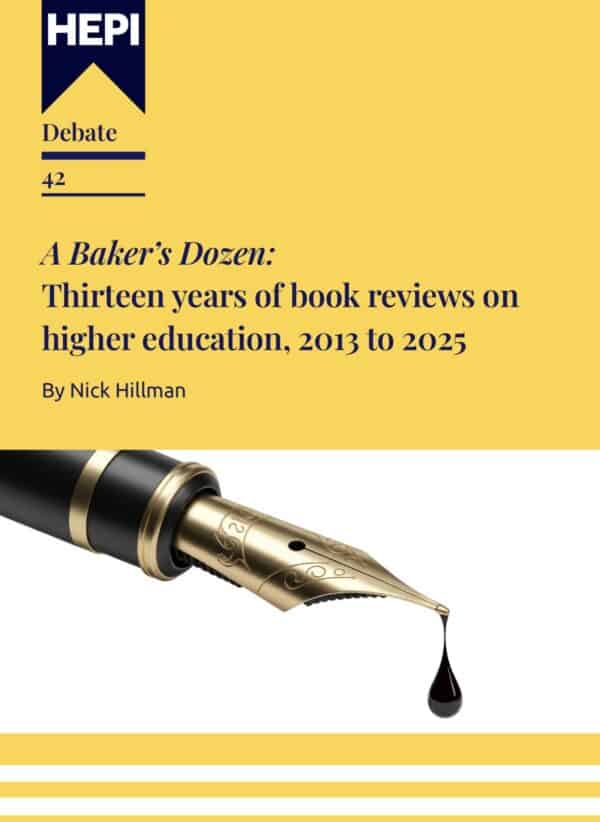Weekend Reading: Is it time to stop using the term ‘non-traditional student’?
This HEPI blog was kindly authored by Dr Steve Briggs, Director of Learning, Teaching and Libraries, University of Bedfordshire
In the context of UK higher education, the terms ‘traditional’ and ‘non-traditional’ are widely used when describing students – as apparent in recent blog posts published by HEPI. In this blog, I consider why the continued use of such terminology may become increasingly problematic and what might be a viable alternative.
Who are ‘traditional’ students?
The Cambridge dictionary defines ‘traditional’ as:
Following or belonging to the customs of ways of behaving that have continued in a group of people of society for a long time without changing.
As such, one can infer that the criterion for traditional students is that they will share established characteristics that have been fixed for a significant period.
The stereotypical traditional student
In the 1970s and 1980s, university students were generally young adults who left home and moved to a new city or town to study. They would routinely live with other students on or near to campus. Many would be able to undertake studies without needing to work and would have significant time available to spend on campus and engage in clubs, societies, sports teams and other social activities. In 2025, many commentators will cite this profile as being synonymous with a traditional student.
The rise of the non-traditional student
In the context of the UK, the term ‘non-traditional student’ has been widely used to differentiate learners who do not adhere to the aforementioned traditional student convention. Examples of characteristics seen to make a student non-traditional include:
- Commuting to university, rather than living on campus
- Being over the age of 21
- Having parental and/or caring responsibilities
- Hailing from a lower socio-economic background
- Being the first-in-family to study at university
- Having had experience of the care system
Such individuals are often time-poor but commitment-rich and in turn have very limited availability to spend on campus outside of scheduled sessions. The use of the non-traditional label has been used increasingly since the advent of widening participation in the 1990s.
Perceptions of traditional are not fixed
The concept of a traditional student is time-bound. For example, pre-1900, there was a small number of ancient universities in the UK and relatively very low numbers of students. Increased numbers of universities opening during the 1900s meant that more individuals were able to study at university, many of whom would be labelled as non-traditional relative to those pre-1900. However, the same group has since then been re-defined as traditional relative to those who studied in the 1990s.
Over the last twenty-five years non-traditional characteristics have become increasingly common amongst the student population. For example, in 2025, HESA reported that over half of students were from IMD quintiles 1 and 2, and the vast majority of students are now over the age of 20. Following previous trends, there will come a point, potentially in the not-too-distant future, whereby the current generation of non-traditional students will become viewed as traditional. The cyclical process will then likely start again with a new conceptualisation of what is non-traditional.
More nuanced classification options
Given the time-bound nature of both traditional and non-traditional characteristics I suggest that higher education commentators should consider the use of more exact terminology when discussing student cohorts. I suggest two options:
- By decade: Student groups could be framed in terms of decades, for example the demographic and characteristics of students of the 1990s, 2000s, 2010s and 2020s, etc. Such an approach could work well if there was stability over a decade however, the impact of social or global events (such as a recession, government policy or pandemic) may mean within a decade those studying within higher education could change markedly. For example, the significant impact of governmental immigration policy changes on the recruitment of international students studying in the UK during the mid-2020s.
- Create generational names: Since 1950, there have been five main birth generations: Baby Boomers, Generation X, Millennials, Generation Z and Generation Alpha. Each generation has shared characteristics synonymous with being born during that period. Analogously, specific generations could be defined in terms of university students. Each generation would have a distinctive name and characteristics common amongst most members studying at university during that specific window of time. The use of student generational names would offer flexibility to account for periods of stability that lasted longer than ten years and could also accommodate sudden changes to the profile of student cohorts.
I personally favour the use of generational names given the greater flexibility. I see this as necessary given the turbulence and change experienced within the higher education sector over the last decade. For instance, I propose that the pandemic was a catalyst for the emergence of a new generation of students, a defining characteristic of which being greater experience in remote communicating and learning online.
Putting into practice
As a starter for ten, I suggest seven generations of English students over the last 150 years. A caricature for each is provided – these are intended to be illustrative of generational difference rather than exhaustive:
- Ancient Generation (pre-1900): A student would study at one of the ancient universities in the UK. Students were mainly from the upper social class, and a fraction of the population attended university. Those attending university would be financially supported by personal networks.
- Redbrick Generation (circa 1900-1945): Most students studied at an ancient or redbrick university. Students continued to be mainly from the upper social class, and in turn a small percentage of the population attended university.
- Post-World War Two Generation (circa 1946-1989): As the number of universities progressively expanded, students had greater geographic access to higher education. Students could access maintenance grants to cover the cost of living whilst studying. This allowed students to readily engage in activities alongside their studies.
- Widening Participation Generation (circa 1990 – 1997): The number of universities significantly increased following the integration of polytechnics. Concentrated efforts were made to expand access to higher education and the percentage of students from previously underrepresented groups increased. In addition to maintenance grants, students were able to access low-cost student loans.
- Tuition Fee Generation (circa 1998 – 2014): The widening participation imperative remained but students now paid a tuition fee to study. Choice of where to study remained limited by student number caps. Maintenance grants were abolished and replaced with student loans. As fees progressively increased more students found they needed to undertake work whilst studying.
- Free Market Generation (circa 2015 – 2019): Widening participation remained a priority. The student number cap is removed, and many universities actively expand the availability of places. Students have unprecedented choice in terms of where to study at university. Tuition fees and living costs remain a challenge for many students and numbers working whilst studying remains very high.
- Pandemic Generation (circa 2020 – current): The pandemic results in a sudden and seismic shift to online education across schools, colleges and universities. This results in students have new experiences and expectations related to online and blended learning. Cost of living increases following the pandemic resulted in more student facing financial hardships in turn resulting in many spending less time on campus. Demand for mental health and well-being support increases.
Analogous to birth generations, I would see that other interpretations of higher education student generation names could emerge through research outputs, thought pieces or social events as opposed to being determined by a single group or professional body. Influential think tanks like HEPI could play a key role in providing platforms for such discussion.
I foresee there potentially being variations in proposed student generational definitions (as is the case with birth generations) but if all are clearly defined, these would all be invaluable for higher education commentators when discussing longitudinal changes in cohorts over time.







Comments
Gavin Moodie says:
Like many such classifications by era, this suffers from huge disparities in ranges. The author’s first era covers 700 years, the next 2 each cover 40 years, and the last 2 only 5 years each? Are we confident that there have been bigger changes in the last 2 decades than in the first 700 years, which included the Black Death, printing, and the scientific revolution?
Reply
Replies
Steve Briggs says:
Hi Gavin, I fully agree – this was very much intended as an illustration rather than comprehensive breakdown. Pre 1900 in particular would certainly need more refinement
Reply
Pete says:
I would extend the “widening participation” generation quite a bit further – my experience of HE with means-tested £1,050 tuition fees (2000-2003) – and ability to repay my far lower student loan – was very different to the experience of someone who went under top-up fees and especially post-2012 students.
Reply
Add comment